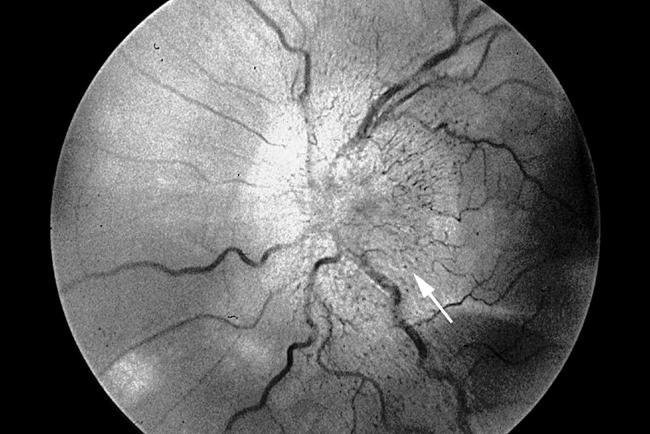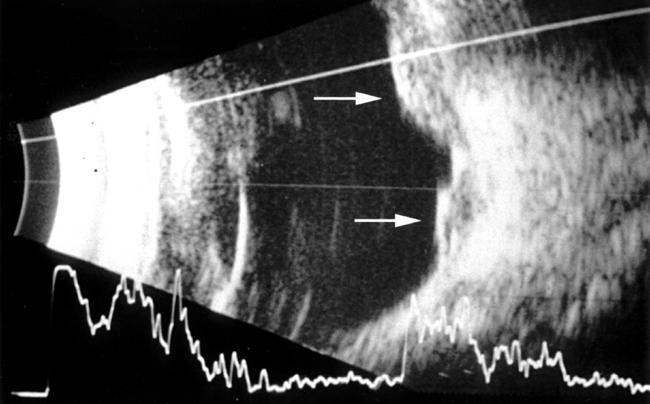Bartonella (previously Rochalimea) henselae is the infectious agent causing cat scratch disease, a self limited regional lymphadenopathy associated with flu-like symptoms.1 In approximately 10% of cases, extranodal dissemination of the organism results in a variety of intraocular inflammatory lesions.1,2 We report a patient with acute Bartonella henselae infection in whom the only physical manifestation was multiple, mass-like lesions in the eye which resembled ocular metastases.
Case report
A 12 year old boy developed daily headaches and blurred vision. Four weeks later, he noted a central grey spot in his left eye. Visual acuity was 20/20 in his right eye and 20/400 left eye. Goldmann perimetry of the left eye revealed a dense central scotoma with steep margins nasally and moderate constriction of the temporal periphery. An afferent pupillary defect was present on the left side. Slit lamp examination was normal in both eyes. Funduscopy of the left eye showed nodular optic disc swelling with peripapillary subretinal elevation (Fig 1). A large creamy-coloured mass (approximately one and one half disc diameter) without exudates or haemorrhages was present in the macula. Several smaller but similar, elevated lesions of the choroid were detected in the periphery as well as an inferior serous retinal detachment. There was no evidence of ocular inflammation. An orbital ultrasound showed the macular lesion to be a solid mass without associated subretinal fluid (Fig 2).
Figure 1.

Fundus photograph of the left optic disc shows diffuse swelling and increased surface vascularity. Additionally, a more focal elevation at the inferotemporal quadrant gives a nodule-like appearance to the disc swelling (arrow). The irregular white spot at the lower left corner of the figure is a photographic artefact.
Figure 2.

Orbital ultrasound at the macula of the left eye demonstrates a focal area of elevation and high reflectivity consistent with a solid mass lesion (arrows).
Complete blood count, electrolytes, and glucose were normal. A sedimentation rate was marginal at 18 mm/hour (normal less than 15 mm/hour). Antinuclear antibodies were elevated at 1:320, speckled pattern. Rheumatoid factor was negative. Evaluation for various infectious aetiologies was negative, including Bartonella serologies (IgM and IgG). A systemic evaluation for a primary tumour causing possible ocular metastases was negative. The patient was empirically treated with doxycycline 100 mg twice daily for 10 days. The macular mass and choroidal lesions resolved in 4 weeks. Shortly thereafter, the disc swelling resolved. Because a diagnosis remained lacking, serologies were repeated 1 month later and revealed a marked rise of Bartonella titres, confirming a recent B henselae infection (B henselae IgM = 24, normal less than 16, and B henselae IgG = 1024, normal less than 256). Final visual acuity was 20/70 left eye due to residual peripapillary and macular gliosis.
Comment
The range of ocular findings associated with B henselae continues to expand. The classic follicular conjunctivitis described with lymphadenopathy and fever (Parinaud’s ocular glandular syndrome) is due to direct inoculation of the conjunctiva. Neuroretinitis, a syndrome of acute visual loss associated with optic disc swelling and macular star, was the first established intraocular complication from disseminated Bartonella.3 Since then, other reported intraocular findings include inflammatory chorioretinal white spots, papillitis, serous detachment, vitritis, uveitis, vasculitis, retinal vaso-occlusive disease, and vitreous haemorrhage.1–4 A mass lesion at the optic nerve head has been noted in several instances.4,5 A solitary macular lesion without other ocular inflammatory findings has also been reported.6 Such lesions in the posterior pole have been presumed to represent a massive focus of Bartonella inflammation.
We report a patient with a circumscribed, elevated lesion in the macula as well as other mass-like lesions at the optic nerve head and in the choroid. These lesions occurred in the absence of systemic or ocular inflammation and clinically resembled ocular metastases. This case highlights the importance of recognising the wide spectrum of ocular bartonellosis. Furthermore, clinicians are reminded that cat exposure is not essential for contracting the bacteria and, therefore, Bartonella titres should be obtained whenever there is a clinical index of suspicion, regardless of cat exposure.
References
- 1.Cunningham ET Jr, Koehler JE. Ocular bartonellosis. Am J Ophthalmol 2000;130: 340–9. [DOI] [PubMed] [Google Scholar]
- 2.Ormerod LD, Skolnick KA, Menosky MM, et al. Retinal and choroidal manifestations of cat-scratch disease. Ophthalmology 1998;105:1024–31. [DOI] [PubMed] [Google Scholar]
- 3.Golnik KC, Marotto ME, Fanous MM . Ophthalmic manifestations of Rochalimaea species. Am J Ophthalmol 1994;118:145–51. [DOI] [PubMed] [Google Scholar]
- 4.Solley WA, Martin DF, Newman NJ, et al. Cat scratch disease. Posterior segment manifestations. Ophthalmology 1999;106:1546–53. [DOI] [PubMed] [Google Scholar]
- 5.Cunningham ET Jr, McDonald HR, Schatz H, et al. Inflammatory mass of the optic nerve head associated with systemic Bartonella henselae infection. Arch Ophthalmol 1997;115:1596–7. [DOI] [PubMed] [Google Scholar]
- 6.Pollock SC, Kristinsson J. Cat-scratch disease manifesting as unifocal helioid choroiditis. Arch Ophthalmol 1998;116:1249–51. [PubMed]


